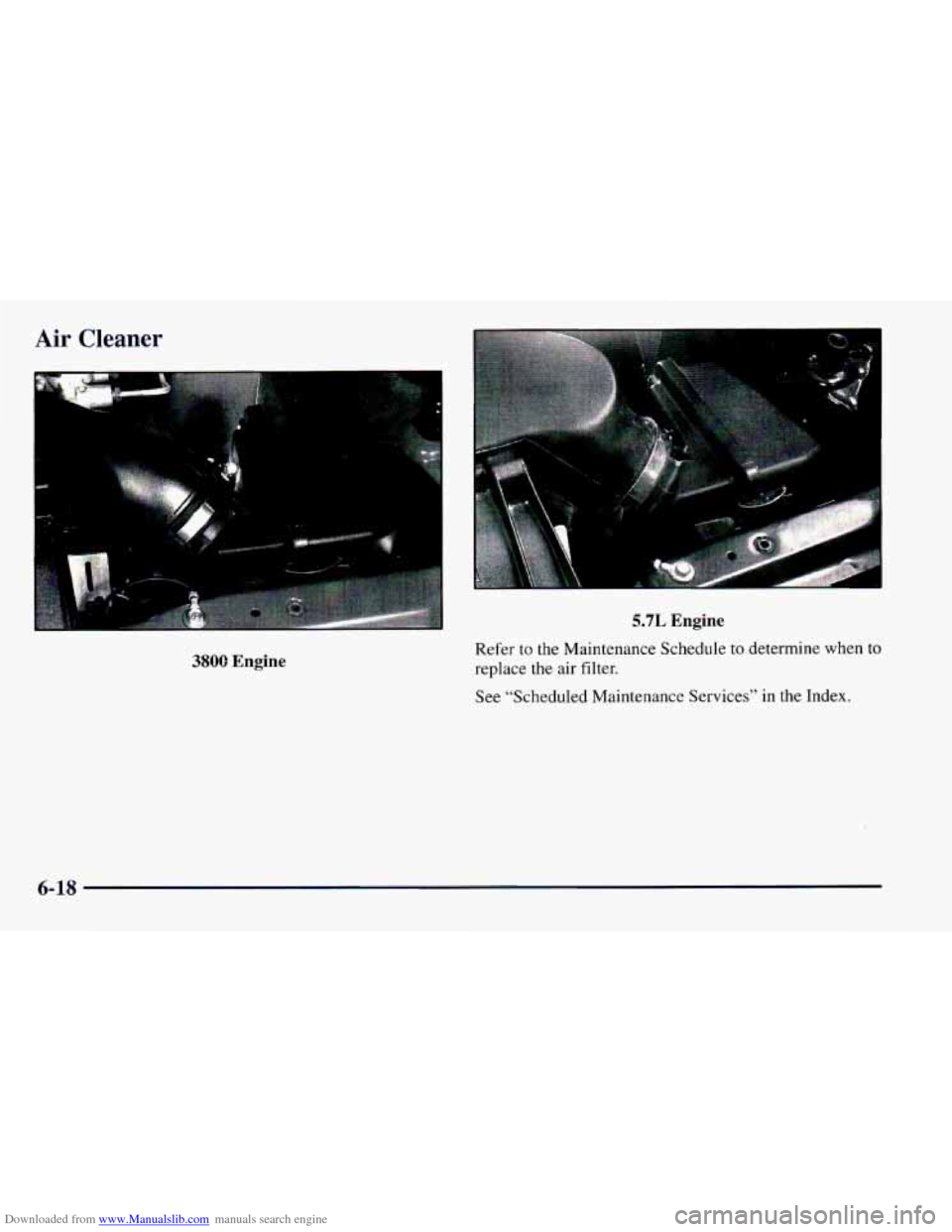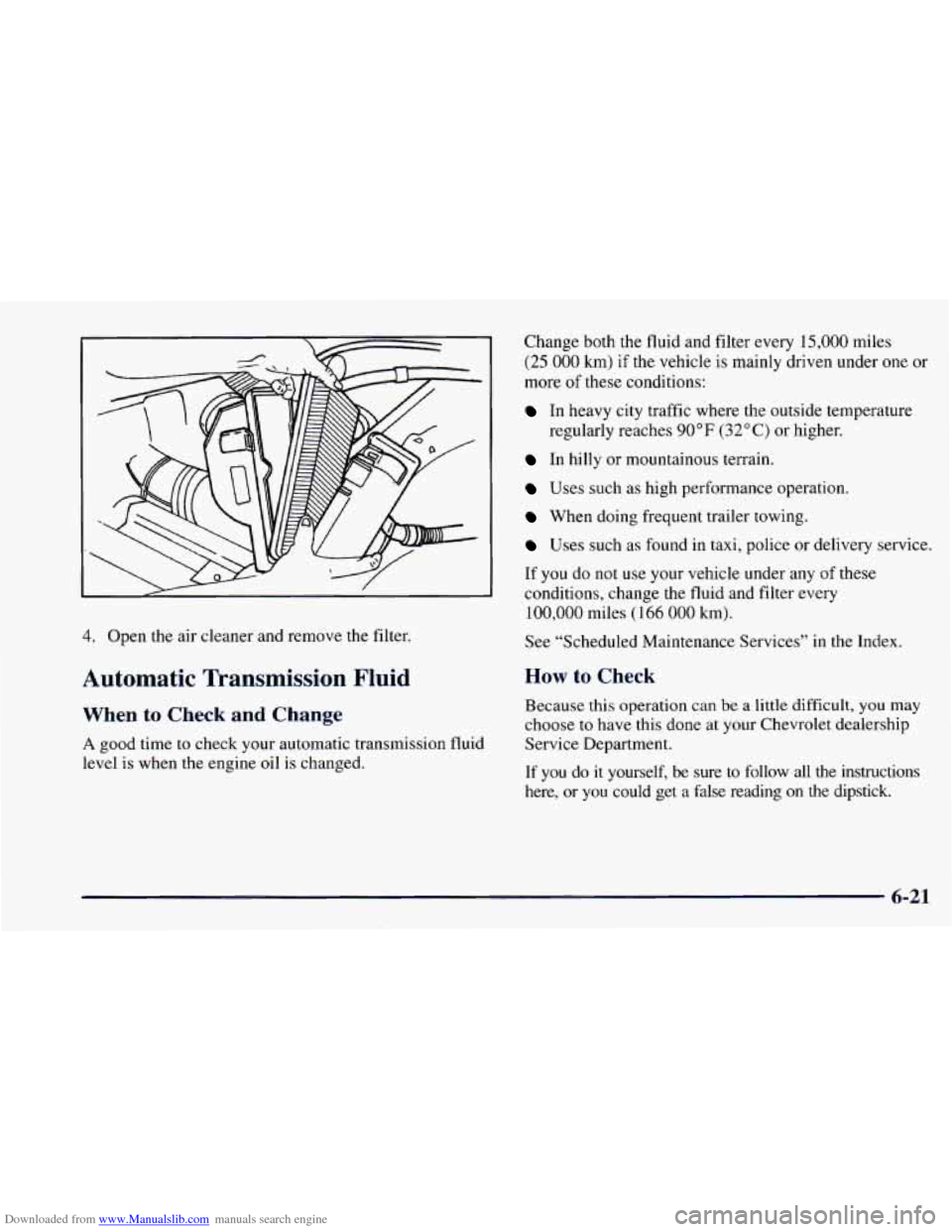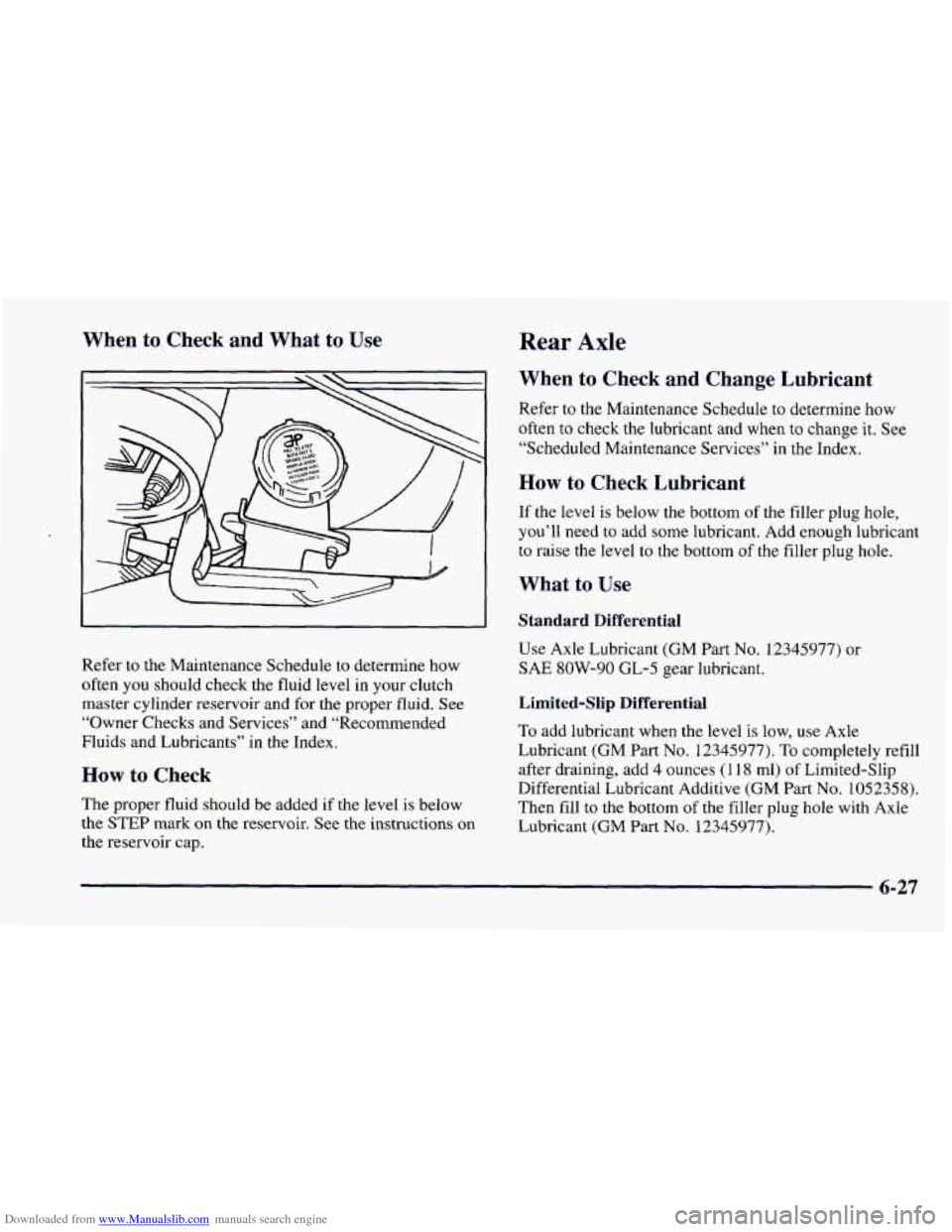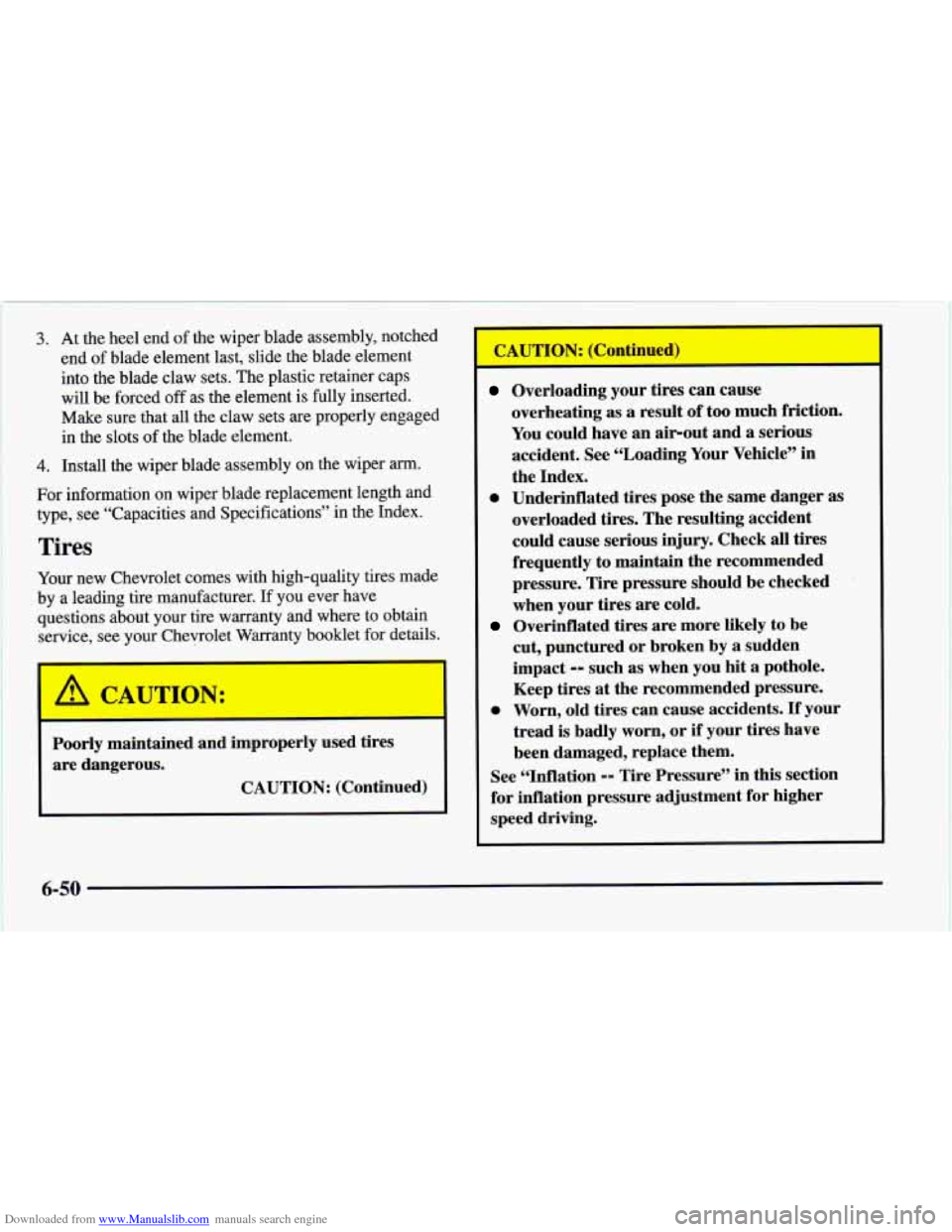1997 CHEVROLET CAMARO service
[x] Cancel search: servicePage 263 of 404

Downloaded from www.Manualslib.com manuals search engine Engine Oil Additives
Don’t add anything to your oil. Your Chevrolet dealer is
ready to advise if you think something should be added.
When to Change Engine Oil
If any one of these is true for you, use the short tripkity
maintenance schedule:
Most trips are less than 5 to 10 miles (8 to 16 km).
This is particularly important when outside
temperatures are below freezing.
Most trips include extensive idling (such as frequent
driving in stop-and-go traffic).
Most trips are through dusty areas.
You frequently tow a trailer or use a carrier on top of
your vehicle.
The vehicle is used for delivery service, police, taxi
or other commercial application.
Driving under these conditions causes engine oil
to
break down sooner. If any one of these is true for your
vehicle, then
you need to change your oil and filter
every
3,000 miles (5 000 km) or 3 months -- whichever
occurs first.
(See “Change Oil Indicator” in the Index.) If
none
of them is true, use the long triphighway
maintenance schedule. Change the oil and filter every
7,500 miles (1 2 500 km) or I2 months -- whichever
occurs first. Driving
a vehicle with a fully warmed
engine under highway conditions causes engine oil to
break down slower.
(See “Change Oil Indicator” in the Index.)
What to Do with Used Oil
Did you know that used engine oil contains certain
elements that may be unhealthy for your skin and could
even cause cancer? Don’t let used oil stay on your skin
for very long. Clean your skin and nails with soap and
water, or a good hand cleaner. Wash or properly throw
away clothing or rags containing used engine oil. (See
the manufacturer’s warnings about the use and disposal
of oil products.)
Used oil can be a real threat
to the environment. If you
change your own oil, be sure
to drain all free-flowing oil
from the filter before disposal. Don’t ever dispose
of oil
by putting it in
the trash, pouring it on the ground, into
sewers,
or into streams or bodies of water. Instead,
recycle it by taking
it to a place that collects used oil. If
you have a problem properly disposing of your used oil,
ask your dealer, a service station or a local recycling
center for help.
6-17
Page 264 of 404

Downloaded from www.Manualslib.com manuals search engine Air Cleaner
rN
--‘
3800 Engine
5.7L Engine
Refer to the Maintenance Schedule to determine when to
replace the air filter.
See “Scheduled Maintenance Services” in the Index.
6-18
Page 267 of 404

Downloaded from www.Manualslib.com manuals search engine 4. Open the air cleaner and remove the filter.
Automatic Transmission Fluid
When to Check and Change
A good time to check your automatic transmission fluid
level is when the engine
oil is changed. Change
both
the fluid and filter every 15,000 miles
(25 000 km) if the vehicle is mainly driven under one or
more
of these conditions:
In heavy city traffic where the outside temperature
In hilly or mountainous terrain.
Uses such as high performance operation.
When doing frequent trailer towing.
Uses such as found in taxi, police or delivery service.
If you do not use your vehicle under any of these
conditions, change the fluid and filter every
100,000 miles (166 000 km).
See “Scheduled Maintenance Services”
in the Index.
How to Check
Because this operation can be a little difficult, you may
choose to have this done at your Chevrolet dealership
Service Department.
If you do it yourself, be sure to follow all the instructions
here, or you could get a false reading on the dipstick.
regularly
reaches
90” F (32°C) or higher.
6-21
Page 271 of 404

Downloaded from www.Manualslib.com manuals search engine How to Add Fluid
Refer to the Maintenance Schedule to determine what
kind of transmission fluid to use. See “Recommended
Fluids and Lubricants”
in the Index.
Add fluid only after checking the transmission fluid
HOT. (A COLD check is used only as a reference.) If the
fluid level is low, add only enough
of the proper fluid to
bring the level up
to the HOT area for a hot check. It
doesn’t take much fluid, generally less than
one pint
(0.5 L). Don’t ove ZZ. We recommend you use only fluid
labeled DEXRON -111, because fluid with that label is
made especially for your automatic transmission. Damage
caused by fluid other than DEXRON-I11
is not covered
by your new vehicle warranty.
%!
After adding fluid, recheck the fluid level as
When the correct fluid level is obtained, push the
described
under
“How to Check.”
dipstick back
in all the way.
Manual Transmission Fluid
When to Check
A good time to have it checked is when the engine oil is
changed. However, the fluid in your manual
transmission doesn’t require changing.
How to Check
Because this operation can be difficult, you may
choose
to have this done at your Chevrolet dealership
Service Department.
If
you do it yourself, be sure to follow all the
instructions here, or
you could get a false reading.
NOTICE:
Too much or too little fluid can damage your
transmission.
Too much can mean that some of
the fluid could come out and fail on hot engine
parts or exhaust system parts, starting a fire. Be
sure
to get an accurate reading if you check your
transmission fluid.
6-25
Page 273 of 404

Downloaded from www.Manualslib.com manuals search engine When to Check and What to Use
Refer to the Maintenance Schedule to determine how
often you should check the fluid level in your clutch
master cylinder reservoir and for the proper fluid. See
“Owner Checks and Services” and “Recommended
Fluids and Lubricants’’ in the Index.
How to Check
The proper fluid should be added if the level is below
the
STEP mark on the reservoir. See the instructions on
the reservoir cap.
Rear Axle
When to Check and Change Lubricant
Refer to the Maintenance Schedule to determine how
often
to check the lubricant and when to change it. See
“Scheduled Maintenance Services” in the Index.
How to Check Lubricant
If the level is below the bottom of the filler plug hole,
you’ll need to add some lubricant. Add enough lubricant
to raise the level to the bottom of the filler plug hole.
What to Use
Standard Differential
Use Axle Lubricant (GM Part No. 12345977) or
SAE 8OW-90 GL-5 gear lubricant.
Limited-Slip Differential
To add lubricant when the level is low, use Axle
Lubricant (GM Part
No. 12345977). To completely refill
after draining, add 4 ounces (1 18 ml)
of Limited-Slip
Differential Lubricant Additive
(GM Part No. 1052358).
Then fill to the bottom
of the filler plug hole with Axle
Lubricant
(GM Part No. 12345977).
6-27
Page 283 of 404

Downloaded from www.Manualslib.com manuals search engine NOTICE:
0
0
Using the wrong fluid can badly damage
brake system parts. For example, just a few
drops of mineral-based oil, such
as engine
oil, in your brake system can damage brake
system parts
so badly that they’ll have to be
replaced. Don’t let someone put in the
wrong kind
of fluid.
If you spill brake fluid on your vehicle’s
painted surfaces, the paint finish can be
damaged. Be careful not to spill brake fluid
on your vehicle.
If you do, wash it off
immediately. See “Appearance Care” in
the Index.
Brake Wear
Unless you have the four-wheel disc brake option, your
Chevrolet has front disc brakes and rear drum brakes.
Disc brake pads have built-in wear indicators that make a
high-pitched warning sound when the brake pads are worn and new pads
are needed. The sound may come and go or
be heard
all the time your vehicle is moving (except when
you are pushing
on the brake pedal firmly).
The brake wear warning sound means that soon
your brakes won’t work well. That could lead to
an accident. When you hear the brake wear
warning sound, have your vehicle serviced.
I NOTICE:
Continuing to drive with worn-out brake pads
could result in costly brake repair.
6-37
Page 296 of 404

Downloaded from www.Manualslib.com manuals search engine ~ 3. At
the heel end of the wiper blade assembly, notched
end of blade element last, slide the blade element
into the blade claw sets. The plastic retainer caps
will be forced
off as the element is fully inserted.
Make sure that all the claw sets are properly engaged
in the slots of the blade element.
4. Install the wiper blade assembly on the wiper arm.
For information on wiper blade replacement length and
type, see “Capacities and Specifications” in the Index.
Tires
Your new Chevrolet comes with high-quality tires made
by a leading tire manufacturer. If you ever have
questions about your tire warranty and where to obtain
service, see your Chevrolet Warranty booklet for details.
Poorly maintained and improperly used tires
are dangerous.
CAUTION: (Continued)
Overloading your tires can cause
overheating as
a result of too much friction.
You could have an air-out and a serious
accident. See “Loading Your Vehicle” in
the Index.
0 Underinflated tires pose the same danger as
overloaded tires. The resulting accident
could cause serious injury. Check all tires
frequently to maintain the recommended
pressure. Tire pressure should be checked
when your tires are cold.
cut, punctured or broken
by a sudden
impact
-- such as when you hit a pothole.
Keep tires at the recommended pressure.
0 Worn, old tires can cause accidents. If your
tread
is badly worn, or if your tires have
been damaged, replace them.
See “Inflation
-- Tire Pressure’’ in this section
for inflation pressure adjustment for higher
speed driving.
Overinflated tires are more likely to be
6-50
Page 298 of 404

Downloaded from www.Manualslib.com manuals search engine How to Check
Use a good quality pocket-type gage to check tire
pressure. You can’t tell if your tires are properly inflated
simply by looking at them. Radial tires may look
properly inflated even when they’re underinflated.
Be sure to put
the valve caps back on the valve stems.
They help prevent leaks by keeping out dirt and moisture.
Tire Inspection and Rotation
Tires should be rotated every 6,000 to 8,000 miles
(10
000 to 13 000 km). Any time you notice unusual
wear, rotate your tires as soon as possible and check
wheel alignment.
Also check for damaged tires or
wheels. See “When It’s Time for New Tires” and
“Wheel Replacement” later in this section for
more information.
The purpose of regular rotation is
to achieve more
uniform wear for all tires on the vehicle. The first
rotation is the most important. See “Scheduled
Maintenance Services” in the Index for scheduled
rotation intervals.
c-
If you don’t have P245/5OZR16 or P275/40ZR17
Goodyear Eagle GS-C tires, use the rotation pattern
shown above for your tires.
6-52